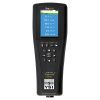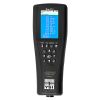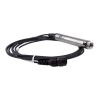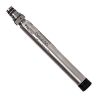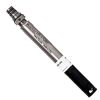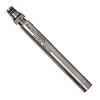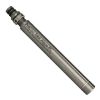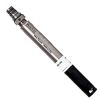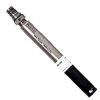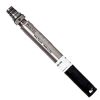YSI ProSwap Digital Water Quality Meter
Features
- Compatible with any ProDSS digital smart sensor for maximum flexibility
- Color display with backlit keypad for sampling in all lighting conditions
- 3 year instrument warranty; 2 year cable warranty (sensor warranties vary)
- Free ground shipping
- Expedited repair and warranty service
- Lifetime technical support
- More
ProDIGITAL Platform for Enhanced Versatility
Connect any ProDIGITAL integrated probe/cable assembly to the ProSwap handheld or any ProDSS digital water quality sensor to the ProSwap cable. Sensors and cable assemblies are user-replaceable with cable lengths ranging from 1- to 100-meters.
ProDIGITAL Smart Sensors
Swap one sensor for another! The ProSwap incorporates smart sensor technology that enables sensors to be automatically recognized by the handheld. Additionally, DIGITAL sensors store calibration data, so probe assemblies can be swapped between handhelds without the need for re-calibration.
Provides Years of Sampling for All Field Conditions
The ProSwap handheld meets the demands of true field work with a rugged, waterproof case (IP-67 rated) and a military-spec (MS) cable connector. Rigorously drop tested from all angles, the handheld features a 3-year warranty, while a 2-year warranty is included with the cable assembly and any sensor variety.
Advanced Data Management
ProSwap includes KorDSS Software, a powerful data management program for easy 2-way communication between the meter and a PC. A unique data backup feature allows for the export of data to a USB flash drive (included) in csv format without having to connect to a computer.
Convenient Sampling Experience
- Ergonomic handheld for a comfortable grip
- Easy-to-read color display and backlit keypad
- Large onboard memory with storage capacity for over 100,000 data sets
- Site ID and Data ID tag capabilities for data organization
- Data export directly to USB flash drive (included)
- Single cable design for probe assembly lengths ranging from 1- to 100-meters
- Long-life rechargeable lithium-ion battery that is user-replaceable
- Simple and quick calibration procedures
| Calibration | 400 detailed calibration records can be stored and are available to view, download, and print |
|---|---|
| Certifications | CEC, CE; RoHS; IP-67; WEEE; FCC; UN Part III, Section 38.3, Test methods for lithium-ion batteries (Class 9) |
| Dimensions |
8.3 cm width x 21.6 cm length x 5.6 cm depth (3.27 in x 8.5 in x 2.21 in) |
| Display |
Color, LCD graphic display; 3.9 cm width x 6.5 cm height |
| Languages | English, Spanish, German, French, Italian, Norwegian, Portuguese, Japanese, Chinese (Simplified & Traditional), Korean, Thai |
| Logging Capabilities | Single point or continuous with autostable feature |
| Memory | 100 user-defined sites and 100 user-defined data ID tags; site pictures can be sent to the handheld via KorDSS, > 100,000 data sets |
| Operating Temperature | 0 to 50 °C (32 to 122 °F) |
| Power | Rechargeable lithium-ion battery pack provides ~48 hours with the handheld only; battery recharge time is ~9 hours with the AC power adapter; the instrument can also be powered via AC or external power pack through the USB port |
| Storage Temperature | 0 to 45 °C (32 to 113 °F) with battery installed; 0 to 60 °C (32 to 140 °F) without battery installed |
| USB | Built-in micro USB On-The-Go port for PC connection, recharging/powering the handheld and connecting directly to a USB stick |
| Warranty |
3-year handheld warranty |
| Weight | 567 grams (1.25 lbs) |
- (1) ProSwap digital display
- (1) Rechargeable lithium-ion battery (pre-installed)
- (1) Hand strap
- (1) USB cable for charging & PC connection
- (1) Universal AC charger
- (1) Cable for connection to USB memory stick
- (1) Quick start guide
- (1) USB memory stick containing KorDSS software and manual
In The News
From Hurricanes to Florida’s Red Tides: Monitoring the Southwest Gulf Coast
Nearly every year, southwest Florida is blighted by harmful Karenia brevis blooms–known colloquially as Florida red tides. These harmful algal blooms (HABs) form over the West Florida shelf and are pushed shorewards by winds and currents. Once in touching distance of the coast, they often intensify, fed by land-based runoff, anthropogenic nutrients, and decomposing marine life killed by toxins produced by these red tides. Red tides have become more severe and persistent over the past 20 years, causing major environmental and economic damage.
Read MoreWave-Powered Buoy Deployed in Puget Sound
While the development of solar-powered monitoring systems has improved access to real-time environmental data, solar power is still limited by low light conditions, such as poor weather, nighttime, or high-latitude environments. To supplement these incumbent power solutions at sea, Ocean Motion Technologies has developed a small-scale ocean wave energy system that can be directly integrated with existing data buoy platforms. Not only does wave energy supplement solar power during periods when the buoys are limited by light availability, but it also allows data buoys to perform beyond their current power capacities.
Read MoreLong-Term Monitoring in the Chautauqua Lake Watershed
With a widely developed shoreline, Chautauqua Lake experiences influxes of non-point source pollution that have historically impacted the health of the lake. The Chautauqua Lake Association (CLA) has been monitoring the lake for over two decades, reporting on changes that have occurred over the years. A pair of local lake advocates, Jane and Doug Conroe, have lived on the lake for over 40 years and have played an important role in establishing monitoring programs and facilitating consistent data collection throughout the watershed. Doug has been involved with the Chautauqua Lake Association (CLA) since the pair moved to the area in 1980, and is currently serving as the Executive Director.
Read More





















































